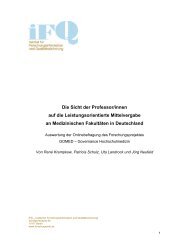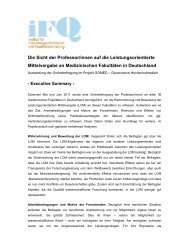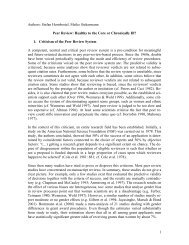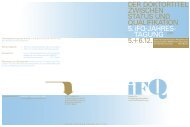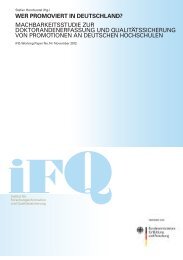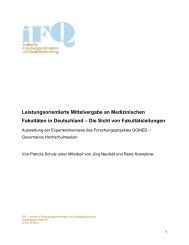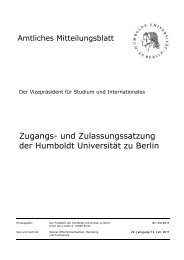Graduate surveys as an outcome evaluation
Graduate surveys as an outcome evaluation
Graduate surveys as an outcome evaluation
Create successful ePaper yourself
Turn your PDF publications into a flip-book with our unique Google optimized e-Paper software.
<strong>Graduate</strong> <strong>surveys</strong> <strong>as</strong> <strong>an</strong> <strong>outcome</strong> <strong>evaluation</strong><br />
Paper published to the 31st Annual EAIR Forum in Vilnius, Lithu<strong>an</strong>ia<br />
23 to 26 August 2009<br />
from Dr. René Krempkow <strong>an</strong>d Ulrich Wilke 1<br />
Key words<br />
Postgraduate study, quality, higher education research design, <strong>evaluation</strong>, employability<br />
Abstract<br />
<strong>Graduate</strong> <strong>surveys</strong> <strong>as</strong> <strong>an</strong> <strong>outcome</strong> <strong>evaluation</strong><br />
The paper deals with the use <strong>an</strong>d potentials of graduate <strong>surveys</strong> in evaluating <strong>outcome</strong>s of higher<br />
education. It covers briefly different applications of graduate <strong>surveys</strong> <strong>an</strong>d <strong>as</strong>pects that have to be<br />
taken into consideration when designing a graduate survey. A special focus is laid on employability<br />
<strong>an</strong>d job success <strong>as</strong> <strong>outcome</strong>s of higher education. Different dimensions of job success are discussed<br />
<strong>an</strong>d determin<strong>an</strong>ts are identified. The Dresden <strong>Graduate</strong> Survey <strong>an</strong>d the Freiburg <strong>Graduate</strong> Survey<br />
serve <strong>as</strong> examples to show import<strong>an</strong>t <strong>as</strong>pects <strong>an</strong>d design issues of <strong>outcome</strong> <strong>evaluation</strong>. Some<br />
exemplary results from these <strong>surveys</strong> <strong>an</strong>d their interpretation are described.<br />
1 Special th<strong>an</strong>ks to Mr. Luk<strong>as</strong> Bischof <strong>an</strong>d Mrs. Annika Vissering (Freiburg University) <strong>an</strong>d Dr. M<strong>an</strong>dy P<strong>as</strong>tohr (Dresden<br />
University of Technology) for support in the <strong>an</strong>alysis <strong>an</strong>d the tr<strong>an</strong>slation.<br />
1<br />
Krempkow / Wilke (2009): <strong>Graduate</strong> <strong>surveys</strong> <strong>as</strong> <strong>an</strong> <strong>outcome</strong> <strong>evaluation</strong>
<strong>Graduate</strong> <strong>surveys</strong> <strong>as</strong> <strong>an</strong> <strong>outcome</strong> <strong>evaluation</strong><br />
The potential of graduate <strong>surveys</strong> for quality m<strong>an</strong>agement<br />
In the context of evaluating higher education, it h<strong>as</strong> been argued, that only graduates are in a<br />
position to adequately <strong>as</strong>sess the study quality, since only they have the needed dist<strong>an</strong>ce to their<br />
course of study. The benefits of graduate <strong>surveys</strong> are mainly in the <strong>as</strong>sessment of outputs <strong>an</strong>d<br />
<strong>outcome</strong>s of higher education (Teichler & Schomburg 1997, p. 246). Professionals in higher education<br />
<strong>as</strong> well see graduate <strong>surveys</strong> <strong>as</strong> a valuable tool. In a survey conducted by Nickel (2007, p. 191) about<br />
the usefulness of different quality <strong>as</strong>sur<strong>an</strong>ce instruments, 89.3% of the respondents rated graduate<br />
<strong>surveys</strong> <strong>as</strong> at le<strong>as</strong>t helpful. 48% of the respondents even rated it <strong>as</strong> a very helpful instrument. This<br />
reflects the import<strong>an</strong>ce <strong>an</strong>d usefulness of graduate <strong>surveys</strong>.<br />
Data that is collected with the help of graduate <strong>surveys</strong> c<strong>an</strong> not only be used to obtain feedback<br />
about the experiences of one cohort of students. The data c<strong>an</strong> also be used to generate indicators for<br />
quality monitoring <strong>an</strong>d <strong>as</strong>sur<strong>an</strong>ce systems (Ziegele 2002, p.11). This feature is incre<strong>as</strong>ingly used by<br />
higher education institutes (HEIs) in Germ<strong>an</strong>y. M<strong>an</strong>y recent <strong>surveys</strong> <strong>an</strong>d research projects c<strong>an</strong> be<br />
stated <strong>as</strong> examples (Schmidt & Horstmeyer 2008; Lojewski 2008; Petzoldt, Schorcht & Haaßengier<br />
2008). Within the b<strong>as</strong>ic model of quality m<strong>an</strong>agement (QM) systems, graduate <strong>surveys</strong> are thus<br />
located in the area of me<strong>as</strong>uring effects of the teaching process of HEIs. In a process‐b<strong>as</strong>ed QM<br />
model such <strong>as</strong> the one suggested by Nickel (2007, p. 44) graduate <strong>surveys</strong> are a tool that is used for<br />
me<strong>as</strong>uring output <strong>an</strong>d <strong>outcome</strong> <strong>an</strong>d thus help to gain feedback <strong>an</strong>d information about further<br />
needed me<strong>as</strong>ures.<br />
Figure 1: Process‐b<strong>as</strong>ed QM model, adapted from Nickel (2007)<br />
However, the mere me<strong>as</strong>urement of <strong>outcome</strong>s, like job success for inst<strong>an</strong>ce, is just the first step of<br />
<strong>an</strong> effective quality <strong>as</strong>sur<strong>an</strong>ce system. To be able to reach conclusions that allow the HEIs to further<br />
develop <strong>an</strong>d improve programs of study <strong>an</strong>d the supporting infr<strong>as</strong>tructure, additional information is<br />
needed. Therefore, graduate <strong>surveys</strong> also need to cover the relev<strong>an</strong>t processes that shape the effects<br />
of teaching within HEIs (Teichler & Schomburg 1997, p. 247). The relev<strong>an</strong>t data must be collected to<br />
2<br />
<strong>Graduate</strong> <strong>surveys</strong> <strong>as</strong> <strong>an</strong> <strong>outcome</strong> <strong>evaluation</strong>
ensure a me<strong>an</strong>ingful interpretation of <strong>outcome</strong>s <strong>an</strong>d <strong>an</strong> <strong>evaluation</strong> of the import<strong>an</strong>t processes.<br />
Besides providing input to review study programs, graduate <strong>surveys</strong> also offer valuable data for other<br />
purposes. Examples are the provision of valuable information for graduates themselves <strong>an</strong>d the use<br />
of the data <strong>as</strong> a b<strong>as</strong>e for a variety of further research topics. <strong>Graduate</strong>s <strong>an</strong>d students c<strong>an</strong> get much<br />
interesting information about which competences are really dem<strong>an</strong>ded by employers <strong>an</strong>d should<br />
therefore be acquired. Other information could be about successful strategies for entering the job<br />
market, <strong>as</strong> well <strong>as</strong> a better b<strong>as</strong>is to get a feeling of the own abilities in comparison to other graduates<br />
<strong>an</strong>d using them for a realistic job search. A graduate survey c<strong>an</strong> be used to collect a wide r<strong>an</strong>ge of<br />
data about the graduates. This data c<strong>an</strong> be used for research in the field of higher education,<br />
economics of education <strong>an</strong>d related fields. One possibility is the use of graduate survey data to<br />
examine competences <strong>an</strong>d their usefulness <strong>as</strong> indicators for <strong>outcome</strong>s of higher education (see<br />
Krempkow 2009). This could be carried out in <strong>an</strong>alogy to PISA <strong>surveys</strong>, like those pl<strong>an</strong>ned by the<br />
OECD <strong>an</strong>d already applied in smaller pilot <strong>surveys</strong> (see the pilots for the AHELO project, TEDS‐M‐<br />
project). Another research question c<strong>an</strong> be about the recruitment of young academics. Faculties <strong>an</strong>d<br />
institutions of HEIs often have further questions about their graduates <strong>an</strong>d c<strong>an</strong> also use the data<br />
from these <strong>surveys</strong>.<br />
Comparability <strong>an</strong>d specific designs<br />
Two import<strong>an</strong>t issues arise in the context of graduate <strong>surveys</strong> <strong>as</strong> <strong>an</strong> instrument of quality<br />
m<strong>an</strong>agement. The first is the issue of comparability. The second is the issue of how specific the<br />
survey is. These two issues produce some tensions in the design of a graduate survey, because they<br />
raise a conflict of objectives. There is some trade‐off between a higher comparability <strong>an</strong>d a more<br />
specific design of the survey. This conflict of objectives needs to be taken into account <strong>an</strong>d the set up<br />
of the survey should try to take both issues into consideration.<br />
Comparability is about the similarity of a graduate survey in comparison to other such <strong>surveys</strong>. Only<br />
in the context of the results of other <strong>surveys</strong>, findings from one survey c<strong>an</strong> be interpreted<br />
me<strong>an</strong>ingfully (Teichler 2002). Data that is collected from one university needs to be compared to<br />
data from other universities. Valid conclusions for one HEI or a certain program of study c<strong>an</strong> only be<br />
drawn, if the <strong>outcome</strong> <strong>an</strong>d processes of the HEIs are really comparable (see also Krempkow 2007).<br />
The second issue is about how specific the design of a survey is with regard to a certain HEI. To cover<br />
special characteristics of a HEI or certain faculties within this HEI or even certain courses of study, it is<br />
necessary to cover <strong>an</strong>y particular feature that h<strong>as</strong> a potentially import<strong>an</strong>t correlation with the<br />
<strong>outcome</strong>. Such institution‐specific <strong>an</strong>d program‐specific <strong>surveys</strong> have <strong>an</strong>other benefit. They enable<br />
the researcher to set <strong>an</strong> optimal timing for the survey <strong>an</strong>d allow conclusions about ch<strong>an</strong>ges over time<br />
within <strong>an</strong> institution or a program. Taking into account specific features leads to <strong>an</strong> optimal use of a<br />
graduate survey for improving the quality of higher education.<br />
The Freiburg <strong>Graduate</strong> Survey tended to incorporate both issues (like the developement of the<br />
Dresden <strong>Graduate</strong> Survey questionnaires before). For that purpose, the questionnaire of the survey<br />
consists of two parts. The b<strong>as</strong>is is a core‐questionnaire that is used in a study which is carried out<br />
nation‐wide in Germ<strong>an</strong>y in cooperation with the International Centre for Higher Education Research<br />
K<strong>as</strong>sel (INCHER). Additionally, this questionnaire is extended with elements to cover institution‐ <strong>an</strong>d<br />
program‐specific features. As a result, in the Freiburg <strong>Graduate</strong> Survey, six different faculty‐specific<br />
versions of the questionnaire were used.<br />
Me<strong>as</strong>uring Outcomes of Higher Education<br />
Since greater employability is <strong>as</strong>sumed to have a “first among equals” position among the goals of<br />
the Bologna Process, HEIs are either obliged or strongly encouraged to <strong>as</strong>sure the achievement of<br />
this goal with a comprehensive system of quality <strong>as</strong>sur<strong>an</strong>ce (Akkreditierungsrat 2008). Some Germ<strong>an</strong><br />
federal states even require their HEIs by law or m<strong>an</strong>agement by objectives to conduct graduate<br />
<strong>surveys</strong> (Schomburg 2007). The Europe<strong>an</strong> St<strong>an</strong>dards <strong>an</strong>d Guidelines for Quality Assur<strong>an</strong>ce (ENQA<br />
2005) state that “institutional self‐knowledge is the starting point for effective quality <strong>as</strong>sur<strong>an</strong>ce. It is<br />
import<strong>an</strong>t that institutions have the me<strong>an</strong>s of collecting <strong>an</strong>d <strong>an</strong>alysing information about their own<br />
activities [...] The quality‐related information system required by individual institutions […] is at le<strong>as</strong>t<br />
expected to cover: employability of graduates”. The Germ<strong>an</strong> Accreditation Council<br />
3<br />
<strong>Graduate</strong> <strong>surveys</strong> <strong>as</strong> <strong>an</strong> <strong>outcome</strong> <strong>evaluation</strong>
(Akkreditierungsrat) requires HEIs to b<strong>as</strong>e their program improvements partly on data on alumni<br />
whereabouts (Akkreditierungsrat 2008). Due to their adv<strong>an</strong>tages on the one h<strong>an</strong>d <strong>an</strong>d the political<br />
requirements on the other, it seems to be natural that graduate <strong>surveys</strong> are experiencing <strong>an</strong><br />
unprecedented boom.<br />
Job success is <strong>an</strong> import<strong>an</strong>t indicator to evaluate the <strong>outcome</strong> of programs of study in Freiburg <strong>an</strong>d<br />
to draw conclusions about what could to be done to improve the quality of the programs. The data<br />
of the Freiburg <strong>Graduate</strong> Survey w<strong>as</strong> <strong>an</strong>alysed to identify determin<strong>an</strong>ts of job success. Factors that<br />
may have a corraltion to the <strong>outcome</strong>, like a strong or weak regional economy, were taken into<br />
consideration to cover the specific context of the <strong>outcome</strong>s. Other specific initial conditions were<br />
taken into account <strong>as</strong> well. In that context, information about the socioeconomic background of the<br />
students is import<strong>an</strong>t (Schomburg & Teichler 1998; Krempkow & P<strong>as</strong>tohr 2006). Generally, the<br />
question to what degree differences in <strong>outcome</strong> c<strong>an</strong> be attributed to differences in the starting<br />
conditions needs to be addressed carefully (see Wissenschaftsrat 2008, p. 78, Krempkow 2007).<br />
The examination of determin<strong>an</strong>ts of job success w<strong>as</strong> realised with the use of multivariate <strong>an</strong>alyses.<br />
This identified the factors influencing job success. In contr<strong>as</strong>t to mere subjective self‐<strong>as</strong>sessments of<br />
the students, such <strong>an</strong>alyses allow more extensive conclusions about factors that have correlations to<br />
job success. For example, one question <strong>as</strong>ked about the graduates’ opinion about what <strong>as</strong>pects they<br />
consider to be import<strong>an</strong>t for employers hiring them. M<strong>an</strong>y graduates rated f<strong>as</strong>t studying, i. e. a short<br />
time needed for completing a program of study, <strong>as</strong> relatively import<strong>an</strong>t. The time students need to<br />
finish their program is also in the focus of m<strong>an</strong>y public discussions about higher education in<br />
Germ<strong>an</strong>y. However, the true direction <strong>an</strong>d magnitude of the correlation of a short study duration is<br />
rarely investigated (see Krempkow & P<strong>as</strong>tohr 2006). With the data collected in graduate <strong>surveys</strong>,<br />
detailed conclusions about such questions c<strong>an</strong> be derived.<br />
The findings <strong>an</strong>d conclusions c<strong>an</strong> thus be very useful for the HEIs to introduce me<strong>as</strong>ures to improve<br />
the perspective of their graduates regarding job success. Furthermore, the findings of the <strong>surveys</strong> are<br />
helpful for the graduates themselves <strong>as</strong> well <strong>as</strong> for future <strong>an</strong>d current students. They c<strong>an</strong> use the<br />
obtained information to <strong>as</strong>sess the import<strong>an</strong>ce of individual actions to correlation the job success,<br />
like using personal networks when searching for a job. <strong>Graduate</strong>s who enter the labour market c<strong>an</strong><br />
use this information <strong>as</strong> well <strong>as</strong> students who have just started their program of study <strong>an</strong>d are<br />
interested in what additional competences are really useful for greater job success.<br />
Job success indicators<br />
Teichler & Schomburg (1997, p. 248) cl<strong>as</strong>sify four different indicator groups for job success:<br />
1. Objective indicators for job success (e.g. income, hierarchical position)<br />
2. Subjective indicators for job success (e.g. job satisfaction, autonomy)<br />
3. Objective indicators for the tr<strong>an</strong>sition period between higher education <strong>an</strong>d job (e.g.<br />
duration of job search)<br />
4. Subjective indicators for the job adequacy with respect to the higher education (e.g.<br />
usefulness of study content, job adequacy)<br />
In the Dresden <strong>Graduate</strong> Survey (Krempkow & P<strong>as</strong>tohr 2006), the variables that were used to<br />
me<strong>as</strong>ure job success are the following: monthly gross income directly after graduation <strong>as</strong> well <strong>as</strong> 12<br />
<strong>an</strong>d 24 months after graduation, job satisfaction <strong>an</strong>d adequacy of job with respect to the conducted<br />
program of study.<br />
As mentioned above, the use of graduate <strong>surveys</strong> <strong>as</strong> <strong>an</strong> <strong>evaluation</strong> instrument needs to be well<br />
designed. The relev<strong>an</strong>t processes in the HEI must be taken into consideration. These processes c<strong>an</strong><br />
be dimensions like individual prerequisites, study conditions <strong>an</strong>d progress, <strong>as</strong> well <strong>as</strong> study results,<br />
which all c<strong>an</strong> have signific<strong>an</strong>t correlation on job success. In that context, Reinfeld & Frings (2003,<br />
p.286) state that, if the goal of the graduate survey is to get conclusions beyond a pure description of<br />
the job success, individual characteristics like gender, social background, age, motivation for studying<br />
<strong>an</strong>d so on, have to be included. Otherwise, there is a high risk of misinterpreting the results. In<br />
particular settings with a wider time horizon need to take personal motivations to pursue a career or<br />
family orientation into account <strong>as</strong> well. Figure 2 shows a diagram of such a b<strong>as</strong>ic model of<br />
determin<strong>an</strong>ts of job success <strong>an</strong>d a frame, presenting the potential p<strong>an</strong>el design of a graduate survey.<br />
During the Dresden <strong>Graduate</strong> Survey (Krempkow & P<strong>as</strong>tohr 2006), approximately 4.000 graduates in<br />
4<br />
<strong>Graduate</strong> <strong>surveys</strong> <strong>as</strong> <strong>an</strong> <strong>outcome</strong> <strong>evaluation</strong>
total were <strong>as</strong>ked to fill out a questionnaire. The response rate w<strong>as</strong> about 50%, i. e. approximately<br />
2.000 <strong>an</strong>swers that could be used for <strong>an</strong>alyses were returned. The rate of response showed<br />
considerable differences among the different faculties which were included in the survey. The<br />
response rate r<strong>an</strong>ged from 34% to 69%. The resulting sample of graduates w<strong>as</strong> checked for<br />
representativity. A comparison <strong>an</strong>d test of relev<strong>an</strong>t <strong>as</strong>pects of the sample showed no signific<strong>an</strong>t<br />
differences between the sample <strong>an</strong>d the population of all graduates of the University of Dresden.<br />
According to this close match, the sample w<strong>as</strong> considered to be representative for the b<strong>as</strong>ic<br />
population in the faculties.<br />
In the Freiburg <strong>Graduate</strong> Survey, the population of graduates w<strong>as</strong> smaller. Approximately 2.000<br />
graduates were reached via postal mailing or e‐mail. The response rate w<strong>as</strong> 51%, also showing<br />
considerable differences between the faculties. A test of relev<strong>an</strong>t <strong>as</strong>pects of the sample in<br />
comparison to the population showed slight differences for some subjects in the <strong>an</strong>alysed faculties.<br />
In this c<strong>as</strong>es further <strong>an</strong>alyses need to be carried out to examine the source of these differences.<br />
Moreover, possible bi<strong>as</strong>es that could arise from these differences have to be examined. In the<br />
presented <strong>an</strong>alyses the subjects <strong>an</strong>d the faculties were clustered into faculty groups. The sample in<br />
the faculty groups were representativ for the b<strong>as</strong>ic population.<br />
Figure 2: B<strong>as</strong>ic model of determin<strong>an</strong>ts of job success (adapted from Krempkow & P<strong>as</strong>tohr 2006)<br />
Factors correlating to job success: Some exemplary results <strong>an</strong>d their interpretation<br />
Figure 3 shows some results of the Freiburg <strong>Graduate</strong> Survey. In this table, the st<strong>an</strong>dardized<br />
regression coefficients are listed for the dependent variable monthly income of the current<br />
occupation at the time of the study. Depending on the exact date of finishing their study, the<br />
graduates had started to work one to two years ago (me<strong>an</strong>: 1.5 years). In the left column, there are<br />
5<br />
<strong>Graduate</strong> <strong>surveys</strong> <strong>as</strong> <strong>an</strong> <strong>outcome</strong> <strong>evaluation</strong>
the factors which are <strong>as</strong>sumed to have a correlation to the <strong>outcome</strong>. They consist of individual<br />
characteristics, details about the course of study, skills <strong>an</strong>d abilities, motivations <strong>as</strong> well <strong>as</strong> specific<br />
circumst<strong>an</strong>ces. All these factors have been selected carefully. Crucial for the choice were theoretical<br />
considerations. For this purpose, the current scientific literature <strong>an</strong>d findings from other empirical<br />
studies <strong>as</strong> well <strong>as</strong> discussions in seminars <strong>an</strong>d workshops have been used <strong>as</strong> a foundation to develop<br />
a hypothesis for each potential factor of influence. Those hypotheses include the direction of<br />
correlation.<br />
The sample of the graduates w<strong>as</strong> divided into three groups according to their program of study. 2<br />
Those groups are the graduates from medical studies, social sciences <strong>an</strong>d technical studies. 3<br />
Among these three groups, there are considerable differences in the dependent variable, the<br />
monthly gross income. The me<strong>an</strong>s of the three groups r<strong>an</strong>ge from 1.600€ to 3.600€.<br />
The expl<strong>an</strong>atory power of the model differs between the three groups 4 , suggesting that the model<br />
h<strong>as</strong> no expl<strong>an</strong>atory power for the group of graduates from technical studies. Furthermore, the<br />
relatively small size of this group raised some methodological problems. 5 Therefore, to derive<br />
conclusions for the graduates of technical studies <strong>an</strong>d forestry, a smaller model w<strong>as</strong> calculated. This<br />
model incorporates ten potential factors of correlation. 6<br />
The present results show, that for the graduates of medical studies <strong>an</strong>d social sciences the final grade<br />
of the matriculation st<strong>an</strong>dard of the graduates shows a signific<strong>an</strong>t correlation. However the direction<br />
of the results differs between the groups. The ambition to pursue a career h<strong>as</strong> a correlation for all<br />
three groups of graduates. 7 The strength of this effect is similar for the three groups.<br />
Regression coefficients for monthly income of current occupation<br />
6<br />
<strong>Graduate</strong> <strong>surveys</strong> <strong>as</strong> <strong>an</strong> <strong>outcome</strong> <strong>evaluation</strong><br />
Technical studies<br />
R 2 =.41<br />
adj. R 2 =.00<br />
n=105<br />
Medical studies<br />
R 2 =.25*<br />
adj. R 2 =.11*<br />
n=270<br />
Grade of matriculation st<strong>an</strong>dard ,179 ,223 + -,203*<br />
Gender (male=1) -,320 + -,020 -,100<br />
Finished vocational training before studying (yes=1) ,317 + ,051 ,114<br />
Duration of stay abroad ,182 ,116 ,031<br />
Part time job during semester break ,093 -,141 ,167<br />
Part time job during lecture period -,063 ,104 -,130<br />
Availability of program specific profiles ,053 ,111 ,057<br />
Social <strong>an</strong>d communication skills ,066 ,101 -,146 +<br />
Duration of study -,422* -,004 -,125<br />
Job entr<strong>an</strong>ce age - ,028 ,266 +<br />
Final degree of study -,165 -,012 ,052<br />
Foreign l<strong>an</strong>guage skills -,025 ,080 ,106<br />
Proficiency in own subject ,268 ,010 ,127<br />
Ability to develop new ide<strong>as</strong> <strong>an</strong>d problem solutions -,116 -,115 -,110<br />
Social sciences<br />
R 2 =.20*<br />
adj. R 2 =.08*<br />
n=316<br />
2 The design of the <strong>an</strong>alysis w<strong>as</strong> similar to the Dresden <strong>Graduate</strong> Surveys. This leads to a comparability of results of both<br />
<strong>surveys</strong> in selected <strong>as</strong>pects.<br />
3 Since the number of c<strong>as</strong>es in a fourth group (forestry <strong>an</strong>d related studies) w<strong>as</strong> too small, this group w<strong>as</strong> completely<br />
excluded from the first <strong>an</strong>alysis. Later this group w<strong>as</strong> included in further <strong>an</strong>alyses.<br />
4 The expl<strong>an</strong>atory model w<strong>as</strong> checked for heterosced<strong>as</strong>ticity <strong>an</strong>d collinearity <strong>an</strong>d showed acceptable values for each group.<br />
5 For this re<strong>as</strong>on <strong>an</strong> interpretation of the results of the group of technical studies should be carried out with caution.<br />
6 This smaller model w<strong>as</strong> also calculated for the other two graduate groups (medical studies <strong>an</strong>d social sciences). The<br />
results support the findings of the model with 20 potential factors of correlation. These findings are described in the<br />
following.<br />
7 Furthermore, in the small model (with 10 predictors) this factor is signific<strong>an</strong>t <strong>an</strong>d relev<strong>an</strong>t for income in the same<br />
direction for all groups. The negative correlation states that the stronger the ambition to pursue a career (me<strong>as</strong>ured on a<br />
scale from 1=very import<strong>an</strong>t to 5=not import<strong>an</strong>t at all), the higher is the actual monthly income, no matter to which group<br />
the graduates belong to.
Ability to work efficiently towards a goal -,236 ,066 -,089<br />
Ability to critically rethink own ide<strong>as</strong> <strong>an</strong>d ide<strong>as</strong> of others ,181 -,042 -,058<br />
Use of personal contacts for job search ,063 -,323** ,011<br />
Employers searched for graduates with other study focus -,043 - -,076<br />
Import<strong>an</strong>ce of family -,119 -,004 ,101<br />
Import<strong>an</strong>ce of career ,215 -,209* -,270**<br />
Figure 3: Regression coefficients for the monthly income of current occupation; + / */ ** = signific<strong>an</strong>t on the<br />
10%‐/ 5%‐/ 1%‐level (“‐“ = variable w<strong>as</strong> not included in the expl<strong>an</strong>atory model)<br />
But there are also differences. The values of the regression coefficients show that for different<br />
groups, there are different signific<strong>an</strong>t <strong>as</strong>pects. For the group of graduates from medical studies, the<br />
use of personal contacts is <strong>an</strong>other import<strong>an</strong>t correlation that h<strong>as</strong> a relative strong effect. The<br />
negative correlation states that graduates who use contacts to family, friends <strong>an</strong>d relatives to find a<br />
job have a higher income th<strong>an</strong> graduates who don’t use their personal contacts or don’t have such.<br />
For the graduates from social sciences, social <strong>an</strong>d communication skills <strong>an</strong>d the job entr<strong>an</strong>ce age<br />
have <strong>an</strong> impact. However, these two factors could be considered <strong>as</strong> not being sufficiently signific<strong>an</strong>t.<br />
For the graduates of technical studies, gender <strong>an</strong>d duration of study are signific<strong>an</strong>t factors. 8<br />
The results of the Freiburg <strong>Graduate</strong> Survey show some similarities but also some differences to the<br />
results of the Dresden <strong>Graduate</strong> Survey (Krempkow & P<strong>as</strong>tohr 2006). In the Dresden <strong>Graduate</strong><br />
Survey, the grade of the matriculation st<strong>an</strong>dard before entering a HEI h<strong>as</strong> a signific<strong>an</strong>t correlation on<br />
the monthly income, too. A finished vocational training also h<strong>as</strong> a strong correlation on the income,<br />
while this factor h<strong>as</strong> no impact in the Freiburg <strong>Graduate</strong> Survey. This difference could arise from the<br />
differing focus of the two universities. The University of Freiburg h<strong>as</strong> m<strong>an</strong>y graduates from social<br />
sciences <strong>an</strong>d medical courses of study while the Dresden University of Technology h<strong>as</strong> m<strong>an</strong>y<br />
graduates from natural sciences <strong>an</strong>d technical study programs. It is very likely that a finished<br />
vocational training is more common <strong>an</strong>d more useful in technical studies like engineering compared<br />
to social sciences or medical studies. Another difference is the correlation between gender <strong>an</strong>d<br />
income. In the Dresden <strong>Graduate</strong> Survey, this factor shows a signific<strong>an</strong>t correlation. The results of the<br />
Freiburg <strong>Graduate</strong> Survey suggest a correlation between gender <strong>an</strong>d income only in technical<br />
studies.<br />
A very interesting finding is about the final grade of study <strong>an</strong>d the duration of study. In contr<strong>as</strong>t to<br />
the common point of view that both factors have a strong correlation, the empirical findings do not<br />
support this. Neither in the Dresden <strong>Graduate</strong> Survey nor in the Freiburg <strong>Graduate</strong> Survey does one<br />
of the two show a strong correlation (except for the technical studies in Freiburg). However, the<br />
results suggest that other factors are far more import<strong>an</strong>t. Which factors actually are the import<strong>an</strong>t<br />
ones depends on the program of study, but grade <strong>an</strong>d duration of study do not belong to them.<br />
Another dimension of job success is job satisfaction. In the Dresden <strong>Graduate</strong> Survey (Krempkow &<br />
P<strong>as</strong>tohr 2006), the most influential factors again differ between the different groups of graduates.<br />
For the graduates of natural sciences, the socioeconomic background <strong>an</strong>d vocational training before<br />
studying are the most import<strong>an</strong>t factors. Among the graduates from technical studies, gender h<strong>as</strong> a<br />
strong correlation showing that female graduates are less satisfied with their jobs. Import<strong>an</strong>t factors<br />
influencing the job satisfaction of graduates from social sciences are the family focus <strong>an</strong>d self‐<br />
<strong>as</strong>sessed expertise. Both factors show a negative impact on the level of satisfaction.<br />
Having a job which is considered to be adequate to the conducted course of study is <strong>an</strong>other <strong>as</strong>pect<br />
of job success. In the Dresden <strong>Graduate</strong> Survey, the state of the labour market (me<strong>as</strong>ured through<br />
difficulties in the job search) strongly correlates with the job adequacy, <strong>as</strong> w<strong>as</strong> expected. For the<br />
graduates of technical studies, gender again seems to play a strong role. The tendency is that female<br />
graduates report a lower job adequacy.<br />
A detailed discussion of these <strong>as</strong>pects of job success (job satisfaction <strong>an</strong>d job adequacy) will be<br />
carried out <strong>as</strong> well for the results of the Freiburg <strong>Graduate</strong> Survey in the future.<br />
8 In the small model the factor use of personal contacts is signific<strong>an</strong>t too.<br />
7<br />
<strong>Graduate</strong> <strong>surveys</strong> <strong>as</strong> <strong>an</strong> <strong>outcome</strong> <strong>evaluation</strong>
Concluding remarks<br />
<strong>Graduate</strong> <strong>surveys</strong> are a useful instrument for evaluating <strong>outcome</strong>s. They c<strong>an</strong> be used to gather<br />
valuable data for a variety of purposes. In the context of improving study programs, graduate <strong>surveys</strong><br />
need to cover all relev<strong>an</strong>t processes within a HEI <strong>an</strong>d include data about the socioeconomic<br />
background <strong>an</strong>d motivations. For a me<strong>an</strong>ingful interpretation of the results, a graduate survey must<br />
be comparable to related studies. Furthermore, the survey should cover HEI‐specific characteristics<br />
to ensure <strong>an</strong> optimal use <strong>an</strong>d the inclusion of all relev<strong>an</strong>t <strong>as</strong>pects. When me<strong>as</strong>uring <strong>outcome</strong>s of<br />
higher education, job success c<strong>an</strong> play a crucial role. <strong>Graduate</strong> <strong>surveys</strong> are <strong>an</strong> useful instrument to<br />
gain insight into determin<strong>an</strong>ts of job success.<br />
References:<br />
Akkreditierungsrat (2008). Kriterien für die Akkreditierung von Studiengängen.<br />
http://www.akkreditierungsrat.de/fileadmin/Seiteninhalte/Beschluesse_AR/08.02.29_Kriterien_Stud<br />
iengaenge.pdf.<br />
Europe<strong>an</strong> Association for Quality Assur<strong>an</strong>ce in Higher Education (ENQA) (2005). St<strong>an</strong>dards <strong>an</strong>d<br />
guidelines for Quality Assur<strong>an</strong>ce in the Europe<strong>an</strong> Higher Education Area.<br />
http://www.enqa.eu/files/BergenReport210205.pdf<br />
Krempkow, R. & P<strong>as</strong>tohr, M. (2006). W<strong>as</strong> macht Hochschulabsolventen erfolgreich? Eine Analyse der<br />
Determin<strong>an</strong>ten beruflichen Erfolges <strong>an</strong>h<strong>an</strong>d der Dresdner Absolventenstudien 2000‐2004, Zeitschrift<br />
für Evaluation 1/2006, 7‐37. www.zfev.de.<br />
Krempkow, R. (2007): Leistungsbewertung, Leistungs<strong>an</strong>reize und die Qualität der Hochschullehre.<br />
Konzepte, Kriterien und ihre Akzept<strong>an</strong>z. UniversitätsVerlagWebler, Bielefeld,<br />
www.universitaetsverlagwebler.de/krempkow.html<br />
Krempkow, R. (2009): Von Zielen zu Indikatoren – Versuch einer Operationalisierung für Lehre<br />
und Studium im Rahmen eines Quality Audit. Qualität in der Wissenschaft (QiW) 1/2009, 44‐53,<br />
UniversitätsVerlagWebler, Bielefeld www.universitaetsverlagwebler.de/QiW.html (date 30.07.2009).<br />
Lojewski, U. v. (2008). Qualitätsm<strong>an</strong>agement mit Schwerpunkt Prozessqualität: D<strong>as</strong> Beispiel der<br />
Fachhochschule Münster, Beiträge zur Hochschulforschung 1/2008, 60‐73.<br />
Nickel, S. (2007). Institutionelle QM‐Systeme in Universitäten und Fachhochschulen. Konzepte ‐<br />
Instrumente ‐ Umsetzung. Eine empirische Studie. Gütersloh: CHE.<br />
Pedhazur, E. J. (1997). Multiple regression in behavioral research (3rd ed.). NewYork: Harcourt<br />
Brace.<br />
Petzoldt, J., Schorcht, H. & Haaßengier, C. (2008). Qualitätsm<strong>an</strong>agement für Lehre und Forschung:<br />
Erfahrungen der Technischen Universität Ilmenau, Beiträge zur Hochschulforschung 1/2008, 74‐93.<br />
Reinfeld, F. & Frings, C. (2003): Absolventenbefragungen im Kontext der Hochschul<strong>evaluation</strong>.<br />
Forschungsst<strong>an</strong>d und Perspektiven, Zeitschrift für Evaluation 2/2003, 280‐294.<br />
Schmidt, U. & Horstmeyer, J. (2008). Systemakkreditierung: Voraussetzungen, Erfahrungen, Ch<strong>an</strong>cen<br />
am Beispiel der Joh<strong>an</strong>nes Gutenberg‐Universität Mainz, Beiträge zur Hochschulforschung 1/2008, 40‐<br />
59.<br />
Schomburg, H. (2007). Lecture "Implementierung von entscheidungsnahen Absolventenstudien <strong>an</strong><br />
Hochschulen in Deutschl<strong>an</strong>d" for the workshop „Absolventenstudien“ for the autumn symposium of<br />
8<br />
<strong>Graduate</strong> <strong>surveys</strong> <strong>as</strong> <strong>an</strong> <strong>outcome</strong> <strong>evaluation</strong>
the Projekt Qualitätsm<strong>an</strong>agement (HRK) in Bonn.<br />
http://www.hrk.de/de/projekte_und_initiativen/121_3844.php<br />
Schomburg, H. & Teichler, U. (1998). Studium, Studienbedingungen und Berufserfolg. In: U. Teichler,<br />
H.‐D. D<strong>an</strong>iel & J. Enders (ed.). Brennpunkt Hochschule. Neuere Analysen zu Hochschule, Beruf und<br />
Gesellschaft. Fr<strong>an</strong>kfurt a. M. ‐ New York: Campus, 141‐172.<br />
Teichler, U. (2002). Potentiale und Erträge von Absolventenstudien. Sozialwissenschaften und<br />
Berufspraxis 1‐2/2002, 9‐32.<br />
Teichler, U. & Schomburg, H. (1997). Evaluation von Hochschulen auf der B<strong>as</strong>is von<br />
Absolventenstudien. In Altrichter, Schratz & Pechar (ed.), Hochschulen auf dem Prüfst<strong>an</strong>d. W<strong>as</strong> bringt<br />
Evaluation für die Entwicklung von Universitäten und Fachhochschulen?. Innsbruck‐Wien: Studien<br />
Verlag.<br />
Wissenschaftsrat (2008): Empfehlungen zur Qualitätsverbesserung von Lehre und Studium.<br />
www.wissenschaftsrat.de (date 30.07.2009).<br />
Ziegele, F. (2002). Indikatoren für formelgebundene Fin<strong>an</strong>zzuweisungen. CHE (ed.)<br />
www.ev<strong>an</strong>et.his.de/infoboerse/dok/htm/CHE‐Indikatoren.htm (date 10.01.2002).<br />
Contact Details<br />
Dr. René Krempkow<br />
Institute for Research Information <strong>an</strong>d Quality Assur<strong>an</strong>ce<br />
Godesberger Allee 90<br />
53175 Bonn<br />
Germ<strong>an</strong>y<br />
E‐mail: krempkow@forschungsinfo.de<br />
9<br />
<strong>Graduate</strong> <strong>surveys</strong> <strong>as</strong> <strong>an</strong> <strong>outcome</strong> <strong>evaluation</strong>




